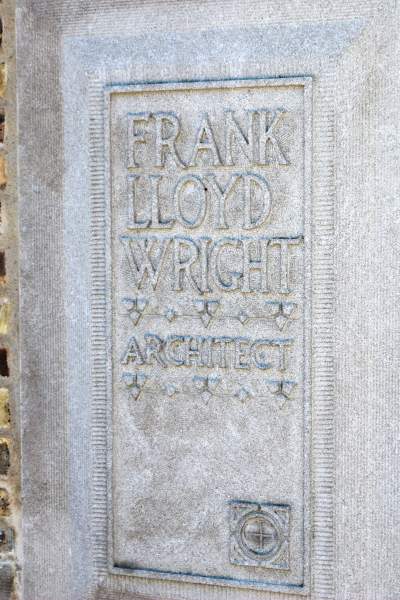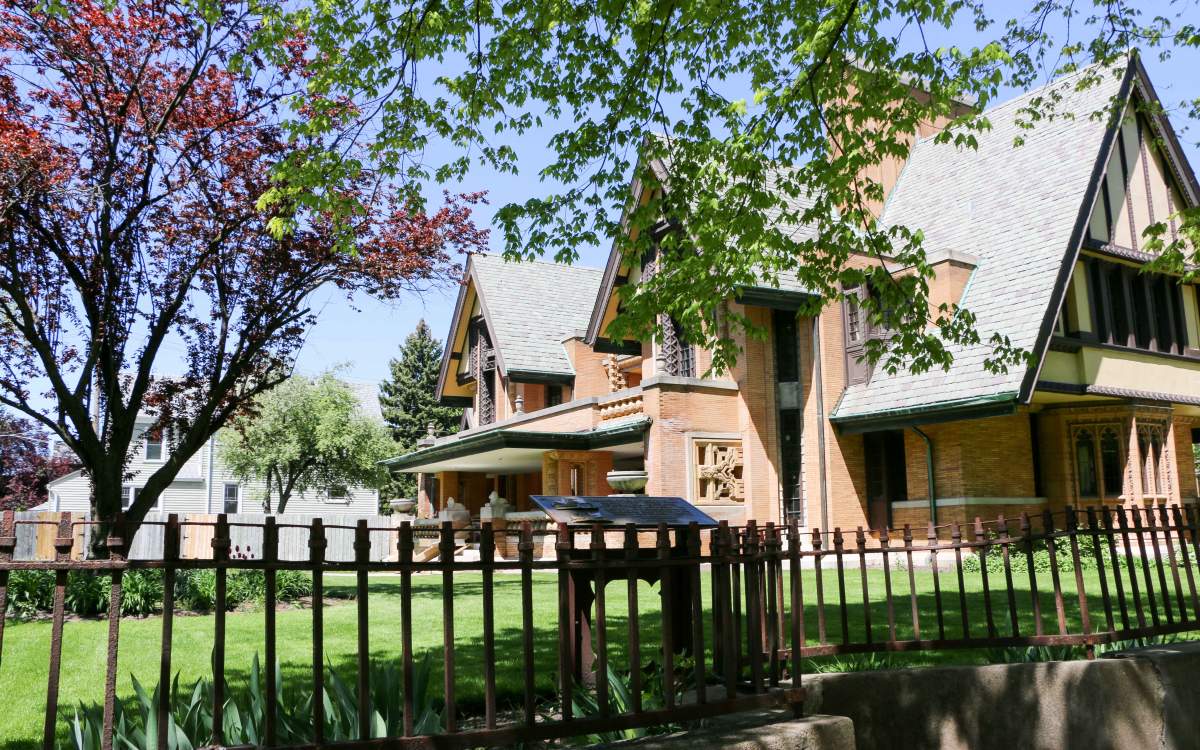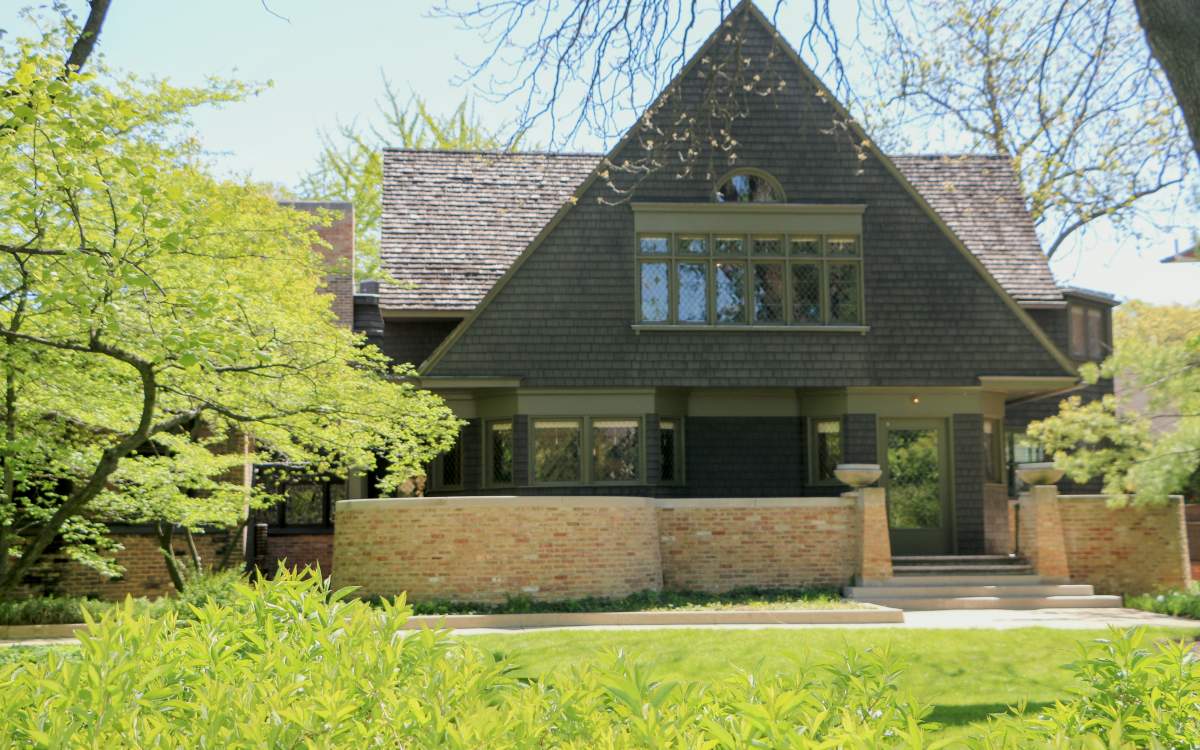
The legendary architect Frank Lloyd Wright made headlines throughout his career for his unique designs—and for his uncanny ability to land in the most salacious of love affairs.
For me, what fascinates about Wright is not just the way he designed his structures so that they seem to spring from their natural surroundings, but also the way he skirted conventional norms in most aspects of his life, exhibiting a consistent willingness to follow his gut rather than bend to societal pressures.
I wanted to learn more about Frank Lloyd Wright during this the anniversary year of his 150th birthday, so I set out for Oak Park, Ill., just 10 miles west of downtown Chicago and the place where Wright began his career, started a family, built his first home and studio, and fell in love with his neighbor.
Wright's Neighborhood
As a young architect, Frank Lloyd Wright designed and built his own home in Oak Park, so it makes sense that he treated the surrounding neighborhood like his personal canvas. As I strolled up Forest Avenue toward Wright’s Home and Studio, the bustling downtown area faded into the beautiful Austin Gardens on my left, while on my right there was telltale evidence of Frank Lloyd Wright.

FRANK W. THOMAS HOME
Built in 1901 and exhibiting many of the traits that would become known as the Prairie Style of architecture, the Frank W. Thomas Home welcomes you to Wright’s neighborhood with a statement. Wright liked to make you work a little to find the entrance to his structures, and that’s evident in the Thomas Home. He also felt that a central fireplace was a key to a family home—a hallmark in full display here.

ARTHUR HEURTLEY HOUSE
Next up, the Peter A. Beachy House (built in 1906) followed by the Arthur B. Heurtley Home (built in 1902). I kept coming back to the Heurtley home on my visit because the light at different times of day seemed to change the entire look of the home. Here, the central fireplace and hidden entryway are evident, as well as the second-story living area, which is also a tenet of Wright's Prairie Style.
MRS. THOMAS H. GALE HOME
Taking a short detour off Forest Avenue and down one of the only winding roads in the grid-like city plan, the home of Laura Gale sits nestled on a tiny plot on Elizabeth Court. The widow of Thomas Gale commissioned Wright to build this cozy home, completed in 1909 and the third home that Wright designed for the family. It’s said that the way the home blends into the landscape around it is a harbinger of the famous Fallingwater house outside of Pittsburgh.


HILLS-DECARO HOUSE
As I headed back to Forest Avenue, I entertained my moderate obsession with the Heurtley home by snapping a few more pictures, before moving on to the Hills-Decaro House that beckoned just across the street. Remodeled by Wright in 1906, the home still shows hints of the different architects who worked on it, but Wright’s distinctive Prairie Style is nevertheless striking. There is also a surprising piece of history tucked into the backyard.
A small structure on the plot, just beyond the home, is an actual ticket booth from the 1893 World’s Columbian Exposition. If you're interested, Wright and his fellow Chicago architects are significant figures in Erik Larson’s book, The Devil in the White City, which recaps that 1839 fair.
MOORE-DUGAL RESIDENCE
Just up the way from that slice of history, a sprawling plot of land boasts the Moore-Dugal Residence as its crown jewel. The home was Wright’s first independent commission after his employer Louis Sullivan discovered that Wright was designing homes outside of his contract—a fireable offense. While there are conflicting stories of the way that the two famed Chicago architects parted ways, it is certain that Wright left the firm of Adler & Sullivan in 1893, so he surely could have used the money from Moore's commission.

The home was completed in 1895, and it is said that Wright had a different vision for the building than that of his client. However, employment was the priority for Wright at the time, so he designed it to Moore’s desires. What makes the home all the more interesting is that it was largely destroyed in a fire in 1922, at which point Wright came back to Oak Park to redesign and rebuild it. I'm sure, even in the ashes, Wright saw a chance to finally fulfill his vision.
BOOTLEGGED HOUSES
Wright did not dispute that he did, indeed, design homes outside of his contract with the firm Adler & Sullivan— a breach that Sullivan discovered as he was walking in his own South Loop neighborhood and stumbled on a home that was distinctly Wright. The architect had a name for the homes he designed on the sly: Bootlegged Houses.
Three of the Bootlegged Houses stand on Chicago Avenue just beyond Wright’s own home. Two of the homes on Chicago are for the Gale family, the same owners of the cozy house on nearby Elizabeth Court.

Frank Lloyd Wright Home and Studio
On the corner of Forest and Chicago avenues, just across the way from the Moore-Dugal Residence, stands the very first home that Wright designed for himself and his first wife, Catherine Tobin Wright. As his practice grew, he later added on an expansive work space, and both the Home and Studio are open for guided tours.
I snagged a ticket and spent a delightful hour wandering through the world of Frank Lloyd Wright just as he saw it.



Once inside the home, it is quickly clear that Wright placed great importance on the concept of a large and central fireplace. You can almost imagine Frank and Catherine sitting around the fireplace and, as the family grew, they would have been joined by some or all of their six children. It’s possible that Wright’s mother, Anna, who lived immediately next door, may have joined them as well, though the relationship between Catherine and her mother-in-law was famously tense—no doubt intensified by their close proximity.
My tour guide informed our group that, if it were up to Wright, he would have chosen to have his family motto, “The Truth Against The World,” emblazoned across the fireplace; however, Catherine chose the less adversarial “Truth Is Life.” It's funny that a story about truth is still unclear, but if Catherine did indeed have her way, this is one of the few places in the home where you can see her touch.
Wright liked to build narrow and low hallways that revealed expansive rooms, and that’s just what he did in his own home where a tight hallway opens into a large room where the family played music, sang, and even hosted small concerts. It’s at the end of this hallway where I imagine Catherine enjoyed some of her best days in her home with Frank.

THE STUDIO
As Wright’s practice expanded, so did his need for space. He added the studio onto his home, connecting his personal life to his professional one by way of a low hallway.
It’s here where Wright and his partners worked before presenting their designs to prospective clients in an adjoining room. Our tour guide informed us that Wright usually had a “Plan B” when he presented a design, but he rarely had to use it due to his persuasive nature. I imagine it had a little to do with his stubborn nature as well.
He may have been persuasive and a bit obstinate, but Wright was not careless. Since fire is the enemy of an architect—especially a Chicago architect, for whom the Great Chicago Fire of 1871 would have been a very recent memory—Wright kept his designs in fireproof cases that could be wheeled into a fireproof safe.
After the tour, I stood outside Wright’s studio and reflected on the grand (and customarily hidden) entrance flanked by two sculptures meant to symbolize a man breaking free from the ground beneath him.
I couldn’t help but wonder if that’s how Wright felt when he left Oak Park in 1909 for Europe—and a new life with Mamah Cheney, his neighbor and the wife of a client. Did he feel like breaking free? My tour guide informed us that Wright left to write a book with a business colleague. They made no mention of the scandal that rocked Oak Park with salacious headlines once it was discovered that both Wright and Cheney had left their spouses—and their children—behind in Oak Park.

The Home That Changed Everything
To understand a bit more about Wright’s decision to leave his family, I wandered the half mile to the Edwin H. Cheney House. It is here where Wright and Mamah Cheney fell in love while Wright was designing a home for Edwin and Mamah. And it is here where it is said that a neighbor looked through the window and saw the two kissing.
As I tried to guess which window the neighbor would have been spying from, I noticed that any neighbor would have had a tough time seeing inside today. As it stands, the home is hard to see behind the overgrown landscaping, but it seems almost fitting that it would be slightly hidden. This is a home that changed everything for Wright. He bucked conventional marriage and left behind his wife and six children, choosing instead a life with a woman who wanted to buck her own conventions, too.
The love affair between Wright and Cheney ended in tragedy. Wright and Cheney returned to America and started work on the Taliesin estate in Wisconsin, a tucked-away sanctuary that would shield Mamah from the persistent headlines and the brutal attacks on her reputation (made worse by the fact that Catherine would not grant Wright a divorce, leaving Cheney an unmarried woman). But their domestic bliss took a devastating turn on August 15, 1914, when an agitated—and likely insane—worker set fire to Taliesin and murdered seven, including Mamah and her two children.
It is said that, though Wright had been married three times, Mamah was his true love. Standing in front of the Cheney home, one can only imagine the toll the couple must have paid for their passion.
Unity Temple
I had one last stop to make on my back to the train station—Unity Temple on Lake Street. Commissioned by the Oak Park Unity Church in 1905, Wright called it his contribution to modern architecture, and indeed it is considered his greatest public work.

The building is fortress-like in appearance, with its concrete cubed presence and trademark hidden entryways, but it is welcoming in the way it seems to fit into Oak Park’s quaint Lake Street. Wright’s father was a preacher, so his religious experience was vast but complicated. Wright has said: “I believe in God, only I spell it in Nature,” and that statement resonates with the design of the temple.
I left Oak Park with a deeper respect for the work of Frank Lloyd Wright and, if it’s possible, even more fascination with the man himself. He was a person who, when presented with a fork in the road, often chose the unconventional route. This is a trait that may have cost him dearly in his personal life, but certainly helped him change the landscape of American architecture.
Tip: Just a quick walk from the centrally located Oak Park CTA Green Line train station, the Oak Park Visitors Center offers a free visitors guide and $4 map of Frank Lloyd Wright sites in the surrounding area. I snagged both and set off on foot, but there are plenty of guided walking or biking tours to choose from.
Information on all these public tours—and more Frank Lloyd Wright sites throughout Illinois—can be found via the Frank Lloyd Wright Trust.
Share your Moments
#EnjoyIllinois


